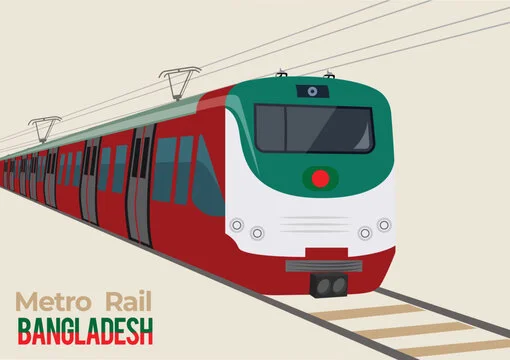Dhaka Metro Rail is a big infrastructure project in Bangladesh. It’s changing the face of the capital’s transportation system day by day. That’s why it’s becoming more efficient and sustainable public transport for the people of Dhaka.
Metro Rail Paragraph
Dhaka Metro Rail, a modern mass rapid transit system, is changing the face of transportation in Bangladesh’s capital. MRT Line 6 first section from Uttara to Agargaon started commercial operation in December 2022, a much-needed alternative to the city’s choked roads. Once completed, MRT Line 6 will have 16 stations and carry 60,000 passengers per hour. The metro rail project is part of a larger plan to reduce traffic congestion and improve air quality in Dhaka. It will save Tk 200 billion, or 2.4 billion dollars per year, equivalent to 1.5% of Bangladesh’s GDP. The project is funded by the Japanese government through the Japan International Cooperation Agency (JICA), which is providing around $2.13 billion, or 75% of the funding for MRT Line 6. The Bangladeshi government is funding the remaining 25%. It’s a big step towards making the city more sustainable and efficient.
Metro Rail Paragraph in 300 Words
The Dhaka Metro Rail, a modern mass rapid transit system, is a game changer for the capital city of Bangladesh. The project is owned and operated by the Dhaka Mass Transit Company Limited (DMTCL) and is part of the Strategic Transport Plan of the Dhaka Transport Coordination Authority to reduce traffic congestion and improve air quality in the city. The metro rail network has 5 lines – MRT-6, MRT-1 and MRT-5- 5 which are under construction, and MRT-2 and MRT-4 which are in the planning stage. The first section of MRT Line 6 from Uttara to Agargaon started commercial operation in December 2022 and is a much-needed alternative to the city’s congested roads.
The second section from Agargaon to Bangladesh Bank started operation in November 2023. Completed, the 20 km MRT-6 route will have 16 stations and carry 60,000 passengers per hour. The project will save Tk 200 billion (around $2.4 billion) per year, which is 1.5% of Bangladesh’s GDP. The $2.7 billion project got Japanese funding in February 2014 and the Japan International Cooperation Agency (JICA) provided around 75% of the funding for MRT Line 6. The Bangladeshi government is funding the remaining 25%. Prime Minister Sheikh Hasina inaugurated the construction work on June 26 in 2016 and contracts for civil construction work were signed in May 2017. The other lines are either in planning or under construction. The third phase of MRT Line 6 will be completed by 2026. MRT-1 will be 31.24 km long,h 12 stations on the Airport Line and 7 stations on the Purbachal Line. MRT Line 5 will have a 20 km northern route with 14 stations and a 20 km southern route underground. The Dhaka Metro Rail is a step towards a more sustainable and efficient transportation system in the city.
Also, read Padma Bridge Paragraph.
Metro Rail Composition
Dhaka Metro Rail revolutionizes transport in Bangladesh’s capital. This cutting-edge transit system belongs to Dhaka Mass Transit Company Limited. It forms a crucial part of the Strategic Transport Plan. The Dhaka Transport Coordination Authority devised this plan to tackle traffic jams and boost air quality.
The metro network boasts five lines. MRT Line 6 runs now. MRT Line 1 and MRT Line 5 are under construction. MRT Line 2 and MRT Line 4 remain in planning. The first stretch of MRT Line 6, from Uttara to Agargaon, kicked off in December 2022. It offers a fresh option to dodge the city’s packed streets. The next section, linking Agargaon to Bangladesh Bank, opened its doors in November 2023.
The MRT Line 6 will stretch 20 km and feature 16 stations when it’s done. It’ll move 60,000 folks each hour. This project has a price tag of $2.7 billion but could save a whopping Tk 200 billion (about $2.4 billion). That’s like 1.5% of the country’s GDP! Japan stepped up big time in February 2014, with their International Cooperation Agency forking over 75% of the cash – that’s $2.13 billion. The Bangladeshi government is chipping in the other 25%, or $690 million. This train line’s going to be a game-changer for this country.

Importance of Dhaka Metro Rail Paragraph
Dhaka Metro Rail is very important for the capital city and its people. As a part of the Strategic Transport Plan of the Dhaka Transport Coordination Authority (DTCA), the metro rail project will revolutionize urban transportation and solve the traffic congestion problem in the capital city. One of the biggest advantages of Dhaka Metro Rail is that it is the severe gridlock that has been plaguing a long time for a long. As the population and economic activities of Dhaka are growing rapidly, the existing road network is getting overburdened and causing long commute times and reduced productivity. The metro rail will provide a much-needed alternative mode of transportation so that people can move around the city quickly and conveniently.
Moreover, it will create a huge positive impact on the economy of the city. By increasing connectivity and reducing travel time, the project will attract investment and boost commercial activities along the routes. This will create jobs, increase productivity, and give an overall boost to the local economy. It will save Tk 200 billion (around $2.4 billion) per year, which is 1.5% of Bangladesh’s GDP. Beyond the immediate benefits, Metro Rail will also transform the city’s urban landscape. By promoting mass transit and reducing dependency on individual vehicles, the project is in line with global best practices for creating eco-friendly and connected cities.
It has a commitment to environmental sustainability with features like noise barriers and vibration-free tracks that will improve the air quality and livability of Dhaka. It’s a transformative project for the city and its people. By providing reliable and efficient transportation, boosting the economy, and promoting sustainable urban development, metro rail will redefine the future of urban mobility in Bangladesh.

